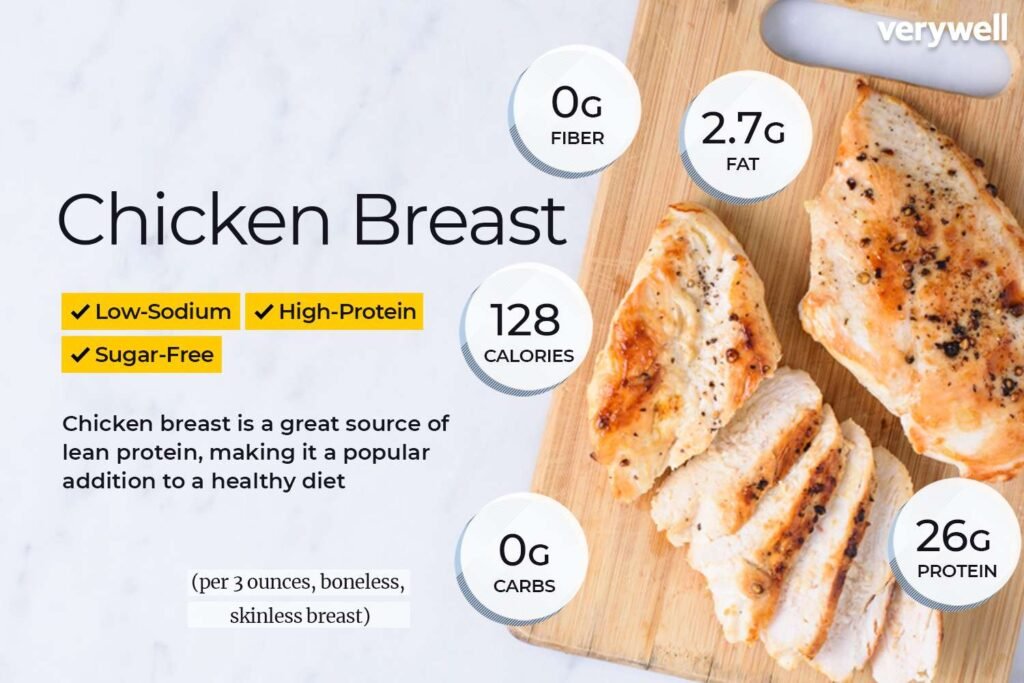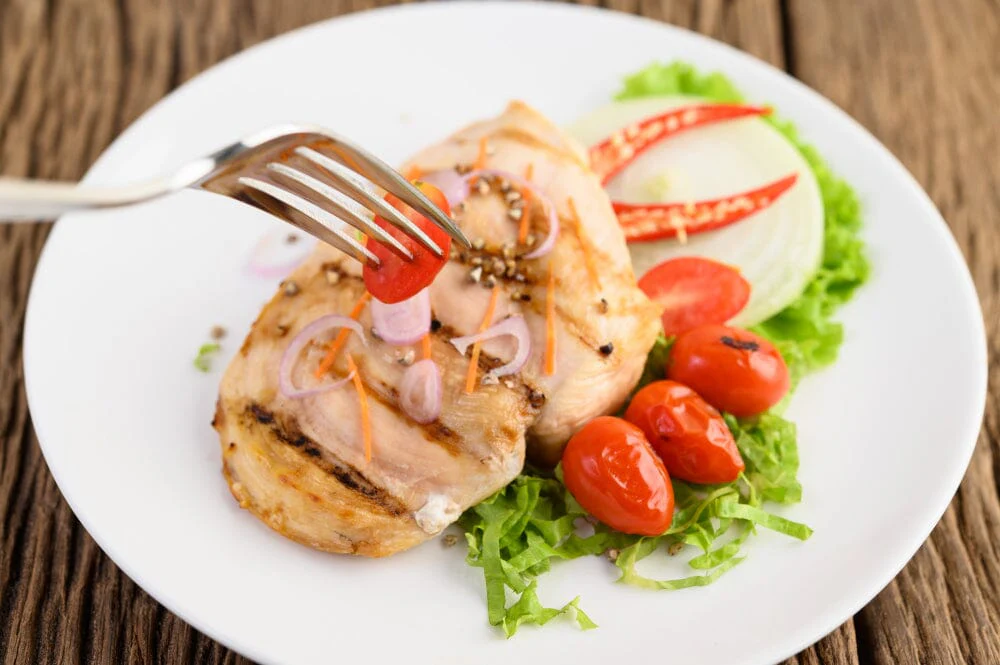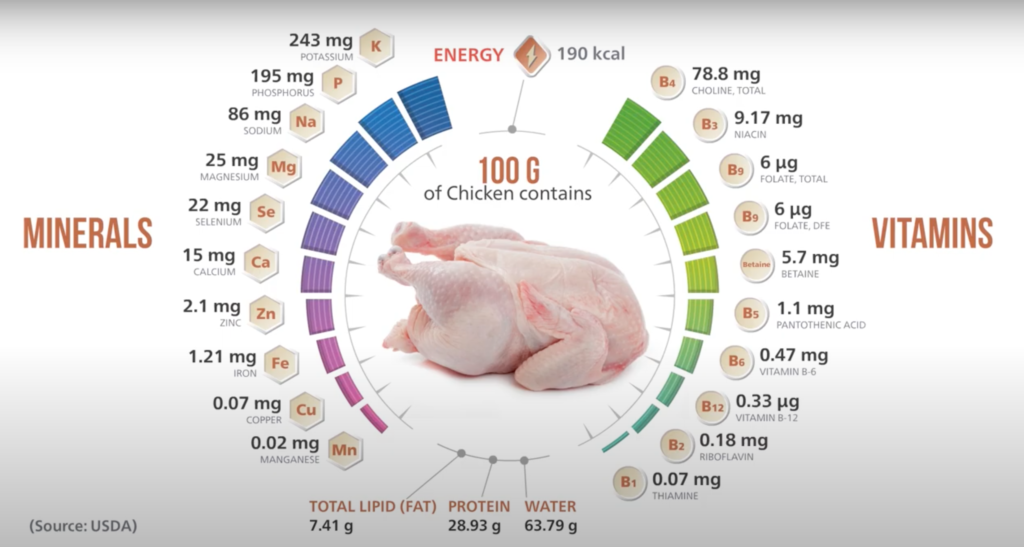Introduction
Chicken breast is a favorite among fitness enthusiasts, home cooks, and anyone aiming for lean protein in their diet. One of the most frequently asked questions is: How much protein is in 100 grams of cooked chicken breast? The general consensus among nutrition databases and food composition tables is that 100 g of cooked, skinless chicken breast contains about 30 to 32 grams of protein.
But behind this simple figure lies more nuance: cooking method, moisture loss, and portion measuring all play roles in variation. In this article you’ll get not just the number, but a clear explanation of why it varies, how to apply it in real-life meal planning, how to measure portions correctly, and answers to common questions people ask. Read on for a user-friendly, trustworthy guide you can apply in your kitchen or nutrition tracking system.

Why the protein figure differs: cooked vs raw
When you see nutrition tables, sometimes the values are for raw chicken, sometimes for cooked. Raw, skinless chicken breast often lists about 22 to 23 grams of protein per 100 g. After cooking, because water evaporates and weight reduces, the protein concentration per 100 g increases—landing commonly around 30 to 32 g for cooked, skinless breast. The key is that total protein in the piece of meat doesn’t magically change; what changes is the weight, and therefore the “per-100 g” measure.
Read More: How Much Protein Is in Chicken?
Typical protein values for chicken breast
Here are commonly accepted reference values for chicken breast (skinless):
| State | Protein per 100 g |
|---|---|
| Raw, skinless | ~22–23 g |
| Cooked, skinless | ~30–32 g |
These numbers reflect averages from food composition databases and lab analyses. Slight variation arises from factors such as cooking style, heat, and moisture retention.
What causes variation in the reported protein number
- Water loss during cooking
The more moisture lost (through roasting, grilling, etc.), the more concentrated the remaining protein becomes in the reduced weight. - Skin or fat remaining
Skin adds fat and weight; many standard tables assume skinless breast. If your piece includes skin or trim, the values shift. - Cooking method and temperature
Methods like steaming or poaching retain more water; grilling or roasting might dry it out more. That affects the resulting moisture and thus concentration. - Added ingredients or coatings
Marinades, sauces, or breading add water, fat, or carbs (not protein), altering the effective “per 100 g” numbers. - Rounding and sample variance
Different labs and food studies use varied samples. Slight rounding or differences in exact sample composition cause small discrepancies.
How to measure and use this in practice
- Decide raw or cooked logging
If you weigh raw ingredients (before cooking), then use raw-value databases for consistency. If you weigh after cooking (as many do for plated meals), use cooked values (~30–32 g per 100 g). - Weigh with a kitchen scale
Visual estimation is often off. A digital kitchen scale gives you accuracy, especially for higher protein targets. - Track additions separately
Oils, sauces, breading do not add much protein, but add calories, fats, carbs. Always log those separately for total macro accuracy. - Be consistent
Always use the same basis (raw or cooked) across meals so your tracking stays coherent.

Meal planning examples using 100 g cooked = 31 g protein
- 150 g cooked chicken breast for lunch:
→ 150 × (31 ÷ 100) = 46.5 grams of protein - Single 100 g cooked serving:
→ about 31 grams of protein - 200 g cooked portion:
→ ~62 grams of protein - If a recipe gives raw weight (say 200 g raw):
Use the raw protein value (~22 g/100 g): 200 × (22 ÷ 100) = 44 g protein. After cooking, your cooked weight might shrink to ~130 g, but the 44 g total remains valid for your meal.
Why chicken breast is a strong protein choice
Chicken breast is a complete protein, meaning it contains all nine essential amino acids in ratios beneficial for growth and repair. It’s relatively low in saturated fat (especially when skinless), and versatile — you can grill, roast, poach, stir-fry, or shred it for salads. Because of its lean profile and reliable protein content, it’s a staple in many balanced diets, strength training plans, or everyday healthy eating.
Cooking tips to preserve nutrition (and palatability)
- Avoid overcooking — it can dry out meat, but won’t reduce protein content significantly.
- Prefer gentler methods (like baking or poaching) to retain moisture if you want juicier results.
- Trim excess fat or skin when aiming for “lean” targets.
- Use minimal added oils or choose healthier oils, especially when calorie control is a goal.
Common misunderstandings clarified
- “Heat destroys protein.”
Not at normal cooking temperatures. Heat denatures protein structure (changes shape), but it does not destroy amino acid content in any meaningful way. - “Cooked has more protein than raw.”
Only per 100 g it appears higher — that’s due to weight loss from water, not added protein. - “Marinades or sauces boost protein.”
No—unless they contain added protein (e.g. yogurt, cheese, protein powder). Most marinades add flavor, moisture, or fat, not protein.

FAQs
Q1: How much protein is in 100 g cooked chicken breast?
A: About 30–32 g of protein in 100 g of cooked, skinless chicken breast, based on standard nutrition data.
Q2: Why is protein per 100 g higher after cooking than before?
A: Cooking removes water weight, concentrating the remaining nutrients — the total protein stays the same but the per-100 g figure increases due to reduced weight.
Q3: Is any protein lost by cooking chicken?
A: Not in meaningful amounts under normal cooking. The amino acids remain; the structure changes but nutritional protein content remains essentially intact.
Q4: Should I log raw or cooked chicken weight when tracking protein?
A: Either is okay — just be consistent. If you weigh raw, use raw-values; if you weigh cooked, use cooked-values (~30–32 g/100 g).
Q5: Does adding oil, sauces, or breading change the protein?
A: Not significantly. These ingredients mainly add calories, fat, or carbs, not protein. If you add them, log their macros separately.
Read More: Dumbbell Forearm Workouts for Stronger Grip
Conclusion
When you need a reliable figure for protein in cooked chicken breast, the best working estimate is around 30 to 32 grams per 100 grams (cooked, skinless). That figure is supported by many nutrition databases and lab analyses, and it holds up across typical cooking methods. The seeming jump in protein from raw to cooked comes from moisture loss concentrating the nutrients — it’s a weight change, not a protein gain. For accurate meal planning and tracking, pick one method (raw or cooked), use matching values, and always log extra ingredients (oils, sauces, breading) separately.
Chicken breast remains a top choice for lean, complete protein in balanced diets. If you like, I can also generate a quick printable cheat sheet showing protein for various cooked-portion sizes (50 g, 100 g, 150 g, etc.), or compare chicken with other meats. Would you like me to prepare that?